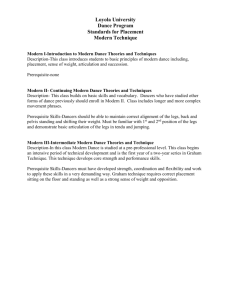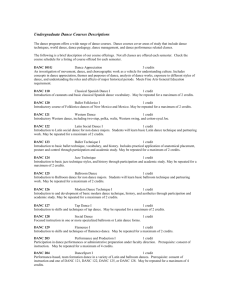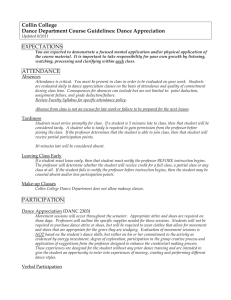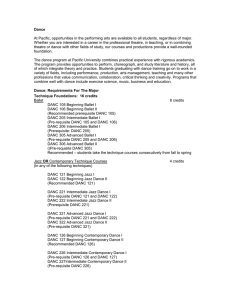New Course Addendum Must be accompanied by a Course Change
advertisement
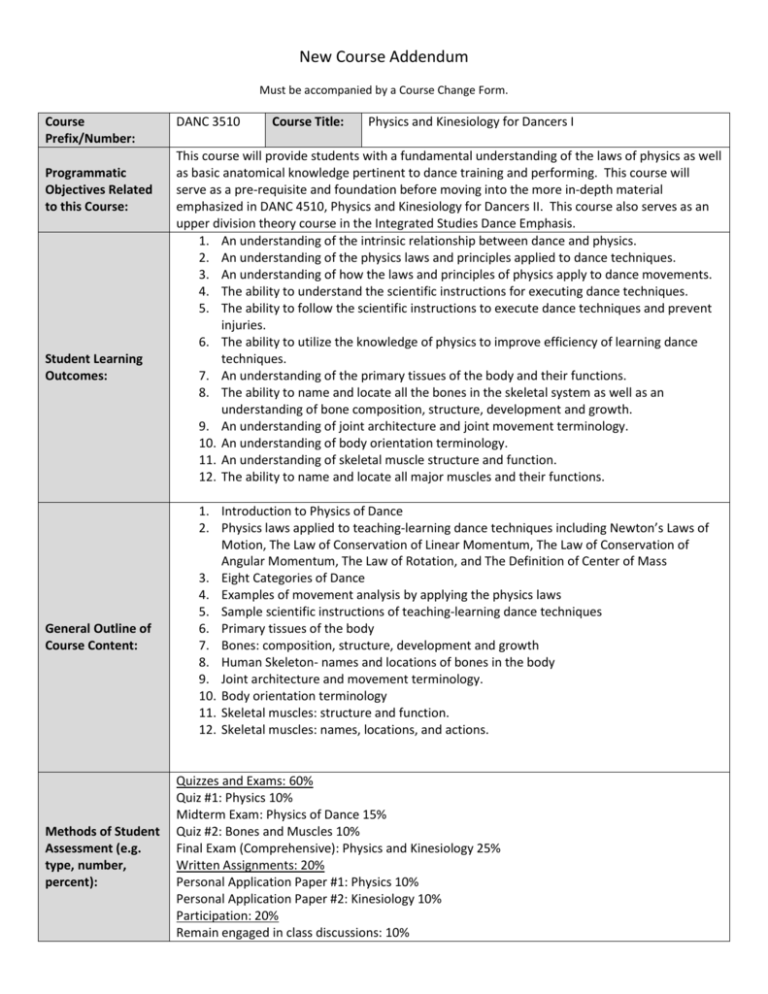
New Course Addendum Must be accompanied by a Course Change Form. Course Prefix/Number: Programmatic Objectives Related to this Course: Student Learning Outcomes: General Outline of Course Content: Methods of Student Assessment (e.g. type, number, percent): DANC 3510 Course Title: Physics and Kinesiology for Dancers I This course will provide students with a fundamental understanding of the laws of physics as well as basic anatomical knowledge pertinent to dance training and performing. This course will serve as a pre-requisite and foundation before moving into the more in-depth material emphasized in DANC 4510, Physics and Kinesiology for Dancers II. This course also serves as an upper division theory course in the Integrated Studies Dance Emphasis. 1. An understanding of the intrinsic relationship between dance and physics. 2. An understanding of the physics laws and principles applied to dance techniques. 3. An understanding of how the laws and principles of physics apply to dance movements. 4. The ability to understand the scientific instructions for executing dance techniques. 5. The ability to follow the scientific instructions to execute dance techniques and prevent injuries. 6. The ability to utilize the knowledge of physics to improve efficiency of learning dance techniques. 7. An understanding of the primary tissues of the body and their functions. 8. The ability to name and locate all the bones in the skeletal system as well as an understanding of bone composition, structure, development and growth. 9. An understanding of joint architecture and joint movement terminology. 10. An understanding of body orientation terminology. 11. An understanding of skeletal muscle structure and function. 12. The ability to name and locate all major muscles and their functions. 1. Introduction to Physics of Dance 2. Physics laws applied to teaching-learning dance techniques including Newton’s Laws of Motion, The Law of Conservation of Linear Momentum, The Law of Conservation of Angular Momentum, The Law of Rotation, and The Definition of Center of Mass 3. Eight Categories of Dance 4. Examples of movement analysis by applying the physics laws 5. Sample scientific instructions of teaching-learning dance techniques 6. Primary tissues of the body 7. Bones: composition, structure, development and growth 8. Human Skeleton- names and locations of bones in the body 9. Joint architecture and movement terminology. 10. Body orientation terminology 11. Skeletal muscles: structure and function. 12. Skeletal muscles: names, locations, and actions. Quizzes and Exams: 60% Quiz #1: Physics 10% Midterm Exam: Physics of Dance 15% Quiz #2: Bones and Muscles 10% Final Exam (Comprehensive): Physics and Kinesiology 25% Written Assignments: 20% Personal Application Paper #1: Physics 10% Personal Application Paper #2: Kinesiology 10% Participation: 20% Remain engaged in class discussions: 10% Contribute to class discussions: 10% Possible Text (or other materials): One of the following for both DANC 3510 and DANC 4510: Dance Kinesiology. Sally Sevey Fit Dance Anatomy and Kinesiology. Karen Clippinger Other Information: Areas in bold are required.








